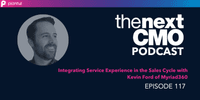Top 5 B2B CMO Actions to Strengthen Marketing Relevance

Alan Gonsenhauser
Principal and Founder, Demand Revenue
CMO (Chief Marketing Officer) tenures have often shrunk to 2 years while B2B marketing has morphed away from a function responsible for events, creatives, and messaging that pushes product or service messages to drive awareness with prospects and customers. These listen to us – “transmission” messages were neither what prospects or customers wanted to hear, nor what the sales folks and channels needed to sell. We were talking more than listening and throwing more money at the problem to “drive” awareness and leads which would hopefully lead to business, eventually. In the digital age, this approach no longer works.
Why? Customers are smarter – they want to buy, not be sold to. Sales teams must be educated as problem consultants and relate to what the customers’ pain points and real needs are. They need to really listen to salient issues and pain points that identify needs. Potential customers search and access content when they wish in their own timeframe. Today people and buying groups do their own research online and often don’t want to interact with a sales person until they are educated and have narrowed down alternatives. Their initial interactions are on-line and they may already have eliminated your brand from consideration without you ever knowing.
So, what should today’s CMO do to increase marketing’s business relevance to the enterprise and ensure their companies and brands remain vibrant? More than ever, CMOs must be facile with left-brain (analytical) and right-brain (creative) thinking. (See Blog: https://www.demandrevenue.com/cmos-what-kind-of-conductor-are-you-jazz-classical-or-both/) To stay relevant and be a strategic partner today, CMOs need to drive more value with five salient actions:
- Cross-functional Alignment with Common KPIs.
- Customer Obsession.
- Relevant Content.
- Differentiated and authentic brands.
- Disruptive Innovation.
Action #1: Cross-functional Alignment with Common KPIs.
CMOs must develop close relationships with their functional peers, such as the CFO and CSO, to drive alignment around growth and customer experience with a common C-suite KPI dashboard.
HINT: If you are not measuring customer lifetime value, start now! More on that below.
Marketing’s alignment with key functional partners is critical to drive profitable enterprise growth and improved customer experiences, reaping huge economic benefits. The C-suite dashboard for marketing should establish a common understanding of what good looks like and demonstrate how marketing contributes to enterprise value. The CMO should partner closely with key functional peers. (Blogs: https://www.demandrevenue.com/category/c-suite-cross-functional-alignment/ )
Action #2: Customer Obsession.
The CMO should help the CEO and functional peers create and continuously improve enterprise customer focus. Ultimately, it’s the CEO’s responsibility to provide the leadership, culture, and autonomy to drive a customer-centric enterprise. He or she can delegate that responsibility to the CMO or another leader to be the key customer evangelist, but must fully support the process. VOC data must be captured, shared, and drive organizational changes at all functional levels. After the initial sale, customer-centric firms need to proactively reach out to customers to understand their real experiences with onboarding, usage, value achievement, and advocacy. Developing strong long-term relationships with clients will naturally impact customer Lifetime Value (LTV) through retention, up-sell, and cross-sales [Blog: https://www.demandrevenue.com/cmos-and-csos-working-together-to-scale-marketing-and-sales/ ]
As an example, a four-step process can be used to monitor cross-functional customer satisfaction levels and changes using the Net Promoter Score (NPS) or another metric. [Blog: https://www.demandrevenue.com/case-study-cmo-customer-experience-turnarounds-through-nps/ ]
HINT: This is great for your customers, but it will also drive long-term profitability and market valuations which interest your CFO, CEO, and the board.
Action #3: Content management.
When it comes to content management, less is more. A content audit normally reveals that up to 80% of your content is unused and should be scrapped. Optimize content for each stage of the customers’ journey from the buying process, and subsequent customer stages of onboarding, usage, value achievement, advocacy, and future sales. Content management needs focus, technology, and analytics to break down the silos with a systematic approach to understand which content is driving the customers’ journey. Less content with more succinct and relevant messaging will be more effective with customers, better received by sales, and save on marketing expenses. How your firm operationalizes content to be easily available at the right moments is also critically important. [Blog: https://www.demandrevenue.com/healthcare-spotlight-top-10-priorities-for-accelerating-sales-with-improved-content/ ]
HINT: Information is not power, access to it is.
Action #4: Differentiated and authentic brand.
Your brand messaging must be meaningful and authentic to your target audiences and communicate a clear and differentiating competitive advantage. CMOs must sharpen brands to ensure a strong emotional connection and provide remarkable value. Looking ahead, brands must help the firm remain viable to changing customer needs, new disruptive technologies, and market entrants. For example, during the COVID 19 pandemic, firms demonstrating empathy for their clients’ needs greatly benefited by new perceptions of authenticity. Once the messaging is succinctly defined and tested with a target audiences, it needs to be wrapped in a robust creative strategy, supporting implementation across many media channels. To optimally leverage the brand, it’s critical to ensure the brand is communicated consistently at every point of contact with target audiences across all communications media and interactions.
HINT: What you actually do must match what you say and how well you say it.
Action #5: Disruptive innovation.
It’s not easy to stay remarkable with technologies, business models, and competitors continually changing. Firms need to be ready to disrupt their own products and business models to avoid being disrupted by a competitor or new entrant. Success can make firms vulnerable and disruptive innovations represent threats to the status quo. New technologies and business models such as cloud, mobile, big data analytics, electronic and autonomous vehicles, global crowdsourcing, outsourcing, wearables, blockchain, crypto currency, and 3D printing are transforming markets, with more convenient, efficient, and lower cost models to get jobs done. CMOs need to catalyze innovation to meet future customer requirements that may not even be known yet by helping to lead a robust innovation pipeline. This requires patience, boldness, and creative breakthrough thinking and determination.
HINT: Success can make you vulnerable: If you don’t disrupt and obsolete your own products, someone else will in time.
Similar Article: How to Measure B2B ROI
Implications and Outcomes for Today’s CMOs
More than ever before, today’s CMOs have a golden opportunity and it’s imperative to be a valued C-suite partner. CMOs must work with the CEO and functional peers to help drive business results, customer centricity, and the firm’s value proposition. This requires general management skills, both creative and analytical to help firms accelerate growth and profitability through customer obsessed transformations.
Demand Revenue accelerates private equity and venture portfolio company ROI by providing Interim CMO (Chief Marketing Officer) Fractional CMO, CMO Executive Advisor & Coaching, and a host of strategic marketing services, and keynote presentations, during critical phases of company transitions at B2B SaaS and Systems health IT, medical device, digital health, and technology and software firms. Visit Demand Revenue to learn more.

